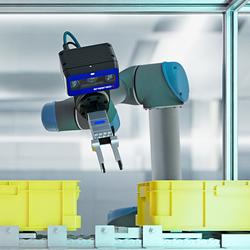New Nanoscale Programmable Switches Promise Faster, More Versatile Chip-scale Devices
DARPAs YFA program identifies and engages rising research stars in junior faculty positions at U.S. academic institutions and introduces them to Department of Defense needs and DARPAs program development process.
By combining complementary mindsets on the leading edges of electronic and radiofrequency device engineering, a pair of researchers in DARPAs Young Faculty Award program has devised ultratiny, electronic switches with reprogrammable features resembling those at play in inter-neuron communication. These highly adaptable nanoscale switches can toggle on and off so fast, and with such low loss, they could become the basis of not only computer and memory devices but also multi-function radiofrequency (RF) chips, which users might reprogram on the fly to behave first like a cell-phones signal emitter but then, say, as a collision-avoidance radar component or a local radio jammer.
Reconfigurable RF systems like these depend on the availability of minuscule RF switches that can be integrated into chips and whose switching characteristics can be readily reprogrammed to serve different RF functions. So far, however, reconfigurable RF switches have been of limited use because of their performance drawbacks including added noise, size, power consumption, functional instability and lack of durability.
As a step toward overcoming these constraints, two of DARPAs Young Faculty Award (YFA) recipients, Qiangfei Xia and Joseph Bardin, both Assistant Professors in the Department of Electrical and Computer Engineering at the University of Massachusetts Amherst, teamed up to invent and demonstrate new nanoscale RF switches based on so-called memristor technology. Bardin (in the YFA program since 2011) brought to the duo expertise in reconfigurable RF integrated circuits, while Xia (in the YFA program since 2012) contributed prowess in the design and fabrication of nanoscale memristor devices. Inspired by discussions with their YFA mentor—DARPAs Microsystems Technology Office Director Bill Chappell—Xia and Bardin combined their strengths to devise what they describe in a recent Nature Communications article as "nanoscale memristive radiofrequency switches."
Memristive devices are switches whose ease or difficulty of toggling between on and off states is determined by the history of voltage and/or current applied to the switch structure. That means they have the potential to be programmed to serve a range of purposes by applying specific patterns of charges. The switches that Xia and Bardin are made of two conductive elements separated by a thin dielectric of just 35 nanometers, or about the width of a virus. Changes in applied voltages or currents in these switches trigger the formation or disintegration of conductive filaments between the elements—a process that resembles neuron signal transmission, where similarly tiny gaps are briefly and reversibly bridged by chemical neurotransmitters, allowing electrochemical signals to propagate from one neuron to the next.
"The nanoscale dimensions of these switches, their performance, and the relative simplicity with which they can be integrated into existing chip technology bodes well for inclusion in a new generation of reconfigurable RF chips. These can change from one type of radio to a completely different type without changing the hardware. We can even use one chip set to switch from a communications system to a radar, which are traditionally very different designs," Chappell said. "The fact that these devices are the brainchildren of an interdisciplinary team adds credence to a longstanding DARPA principle that the intersecting edges of technical fields provide especially fertile ground for innovation. Enabling young faculty at the start of their careers from different backgrounds to collaborate has proven valuable."
DARPAs YFA program identifies and engages rising research stars in junior faculty positions at U.S. academic institutions and introduces them to Department of Defense needs and DARPAs program development process. Since its inception in 2006, the YFA program has provided funding to 272 up-and-coming junior faculty. YFA awardees receive a $500,000 grant over two years, with an opportunity to be considered for an additional $500,000 under the DARPA Directors Award. The YFA program funds a spectrum of basic science research in areas spanning physical sciences, engineering, material sciences, mathematics, biology, robotics, computational social science, and neuroscience. More information about Dr. Xias and Dr. Bardins research can be found, respectively, at http://nano.ecs.umass.edu/ and http://rfic.ecs.umass.edu.
Featured Product

